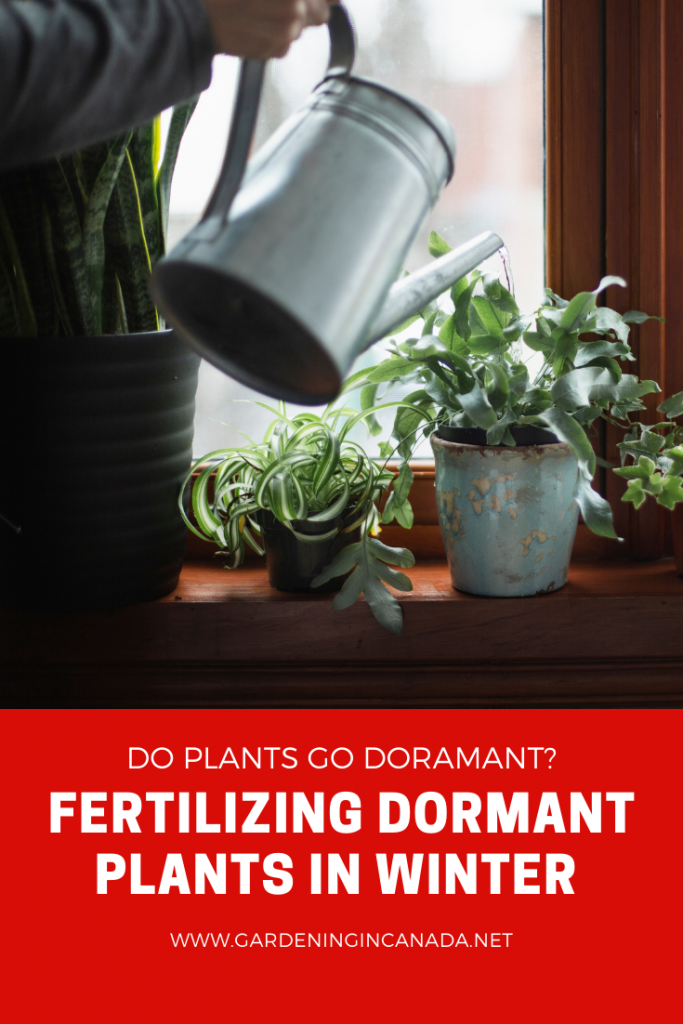- Canada’s Growing Zones Are Changing 2024 - January 12, 2024
- Attracting Wildlife To The Garden - May 16, 2023
- How To Garden Near A Septic Tank - May 9, 2023
Powered by RedCircle
Fertilizing House Plants During The Winter Months?
Should you fertilize house plants during the winter months? The truth is that it is a little bit more complicated than just a simple yes or no answer. As a soil scientist, I promise to bring you the best answer along with a printable worksheet which you can use to determine whether or not your plants need to be fertilized.
If you are new to this blog my name is Ashley and I am a soil scientist. I am located in a Canadian Zone 3 and a USDA Zone 4. I write articles, make YouTube videos, Instagram & Facebook posts all designed for Canadians and Cold Climate gardeners using science-based methods. If you are looking for anything specific be sure to let me know in the comments down below.
Forms of Fertilizers For Fertilizing House Plants During The Winter Months
No, when it comes to fertilizer there are obviously many different forms of fertilizer. You have the organic versus conventional dynamic and then you also have the type of fertilizer. For example, you can have a slow-release, sticks, liquid and granular.
When it comes to organic fertilizers we generally will mix directly into our potting soil. The good news is that it will not affect the plant if there is excess. With any organic fertilizer, it is very difficult to over-fertilize and this is due to the lack of salts present. When it comes to making organic fertilizer, salt is not needed for processing
When it comes to fertilizing with a conventional fertilizer however we do need to be careful of our fertilization. This means if we use a granular or slow-release fertilizer we don’t want to then use a liquid on top of that. If we use the two fertilizers in conjunction we could end up with some burn. This goes for both winter fertilization and fertilization in the summer.
Now if you choose to use a granular fertilizer in your potting soil for your house plants then you don’t want to fertilize on top of that during the winter months. If you’re using sticks in your fertilizer regiment then again you do not want to water with a liquid fertilizer. This blog post about whether or not to fertilize house plants in the wintertime is based on someone who uses liquid and or granular dissolved fertilizer.
For more info on fertilizers check out this blog post.
Looking for new growth
One of the most obvious signs that it is still time to fertilize is active growth. This means the above-ground biomass is still pushing out new leaves. This is a sign that the plant still needs some very much-needed nutrients in order to continue the growth process. It is not uncommon to see a final growth spurt just before winter hits in the fall.
Currently, it is the beginning of November and it would not be uncommon to see growth still at this time. This is especially true if you are growing house plants indoors without grow lights. As the sun changes its position in the sky it is more common for the sun to penetrate farther into our homes. This means that plants that generally do not get adequate sun are now being pelted with the sun. This is because the sun is lower in the sky. Should you fertilize house plants during the winter months if the upper biomass is dormant? lets take a look!
Now if you don’t have new growth in the upper biomass we need to take a look at different signs.
What do trees tell us about houseplant fertilizing during the winter?
Trees covered with snow are probably the most extreme example of dormancy. When we don’t have upper biomass growth in our house plants we technically refer to this as dormant. But the truth is a plant is never truly dormant.
Before modern imaging technology, it was highly debated as to what the roots are doing during dormancy. The excepted theory was that nothing is going on and the plant is simply staying in a bare minimum survival mode. However, with new tech, we are starting to discover that that is not the case.
House plants during the winter months are not dormant. Rather their roots are going into overdrive.
Roots don’t grow at the same rate in all areas.
The roots are doing a ton of different jobs during the winter months. One of those jobs is expanding their volume. This means your house plants are looking for new sources of water and nutrients.
Oddly enough the imaging technology has taught us that roots do not grow at the same rate. This means 1/2 of the plant may have more roots than the other. Is the uneven distribution of root growth is completely natural?
There is an explosion of growth at certain times.
The second thing we have realized about roots is that they go through two pieces of extreme growth. At my extreme, I mean that they are likely to enter new territory that is completely untouched. One of the best times to actually translate your house plants is during these times of rapid expansion.
These two times are very early summer/end of spring and the fall. These are the two times in which the plant is putting a ton of energy into root development. It is likely that this happens so that the plant can support upper biomass for the summer months.
Are houseplants dormant in the winter? & should you fertilize houseplants during the winter months?
The resounding answer to this question of whether or not a houseplant is dormant in the winter is no. There is enough evidence to show that plants are actively growing and performing metabolic processes during the winter months. The lack of upper biomass growth should not confuse you. So should you fertilize houseplants during the winter months?
In reality, the lack of sunlight gives the plant time to focus on roots. Remember there’s a whole other world underneath the soil. Arguably the below-ground biomass is important than the above-ground biomass.
Without the roots, we don’t have a plant. While the above-ground parts look as though they are in dormancy. The roots are actually at the ready. The roots are growing independently of the above-ground parts. This means during the winter the roots are going through a bulking faith in our house plants.
Do house plants need fertilizer during the winter months?
The reality is that house plants do need fertilizer during the winter months. While the roots are expanding there is a high need for extra nutrients. One thing you will notice when you do fertilize in the winter is that the summertime foliage explosion will be much greater.
Turns out the roots are actually using the nutrients present in the soil during the winter months to help fuel the battery for the summer. Whatever’s in the reserve of the plant is then used for that new foliage development in the summer. This means if you choose not to fertilize your house plants during the winter you may have slower or less growth on your house plants.
How do we fertilize houseplants in the wintertime?
The best way to fertilize your house once during the winter months is by following the instructions. I know this may not be what you want to hear but the truth is that these companies don’t want you to burn your plants. That means they already know how much nutrients are in each application and they are keeping all aspects in mind.
For some fertilizers, this may mean fertilizing biweekly while others only require you to do so monthly. The important thing to remember here is that you do not randomly water just to apply fertilizer if the plant does not need it. You want to make sure you water your plants at the correct time.
If the soil is still moist and there is no need for water do not water or fertilize until it is ready.
How To Prepare A Houseplant For Fertilizer
This is all going to be included in the printable copy I gave you. Keep in mind the printable copy can be easily stored in the house plant planner that you can get from Amazon or Etsy. The Amazon version is a paperback while the Etsy version is a PDF copy.
Some of the stuff I’m going to tell you to do may feel scary but I promise that it works. Put your trust in me and we will get through this together.
Step One:
Place your potted plant in a container of water. This should have a flat bottom in it that allows the pot to sit freely. Fill the container with water approximately halfway and allow the water to work its way into the soil. That’ll happen through Capillary action and may take some time. If you need to leave it for an hour or two this is completely OK.
Step Two:
Once the pot is completely saturated, take it out of the water. Now it’s time to give the pot a slight dip. This means you are going to take the top of the pot and you’re going to twist it so it is sideways. This is going to change the field holding capacity of your potted plant. And it will release any excess moisture that may be present in the root zone. We call this excess moisture a perched water table. Purged water tables are notorious for causing root rot.
Step Three:
Run water on the plant. This means you’re flushing the soil and getting rid of any excess salt or nutrients. Lots of nutrients are water-soluble and therefore any excess that may be present is completely washed away. That means you can place the potted plant either in the shower or in the sink. He wants the excess water to be running out the bottom for at least 60 seconds.
Step Four:
It’s officially time to fertilize. Make your fertilizer ingredients based on what the label says. If you are in doubt or scared feel free to quarter or half the suggested amount. Now all you wanna do is simply water the plants and tell the water begins to run out the bottom. This shouldn’t take much time at all and you are done.
I hope you found this guardian Canada article helpful. So the moral of the story is that yes you should fertilize your house plants during the winter months. This is due to the amount of action taking place underneath the soil surface. You will see amazing results if you choose to fertilize during the winter months. You can expect an explosion of growth at the end of spring and the beginning of early summer.
Should you fertilize house plants during the winter months? Will You feritilize houseplants during the winter months going forward?


